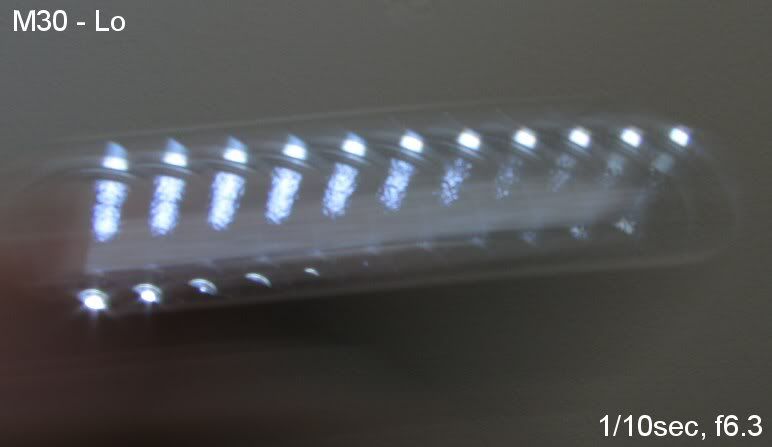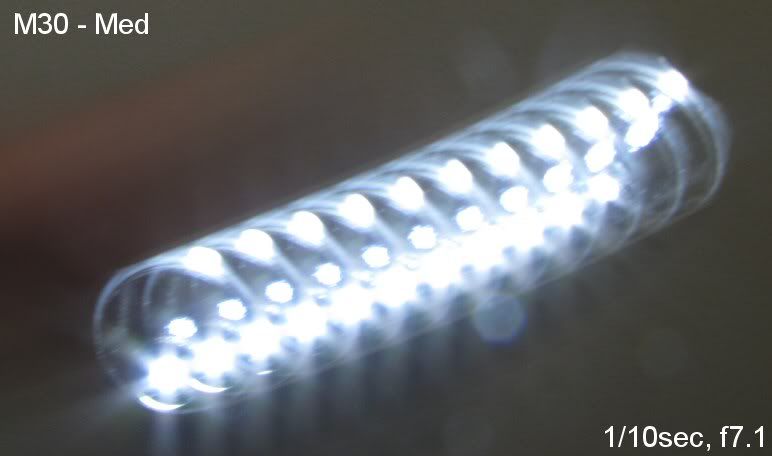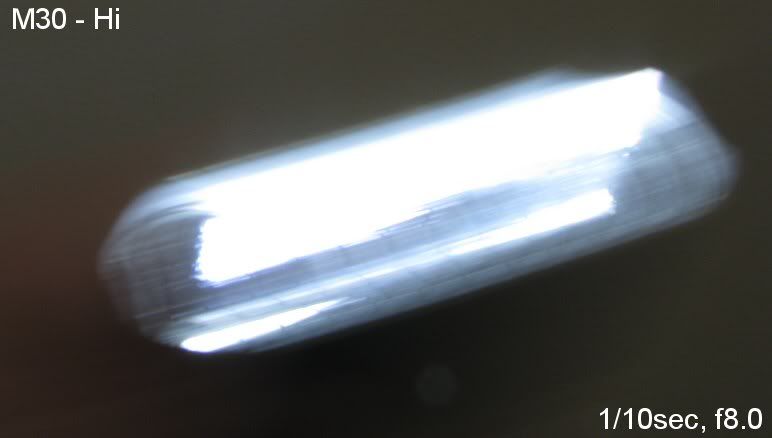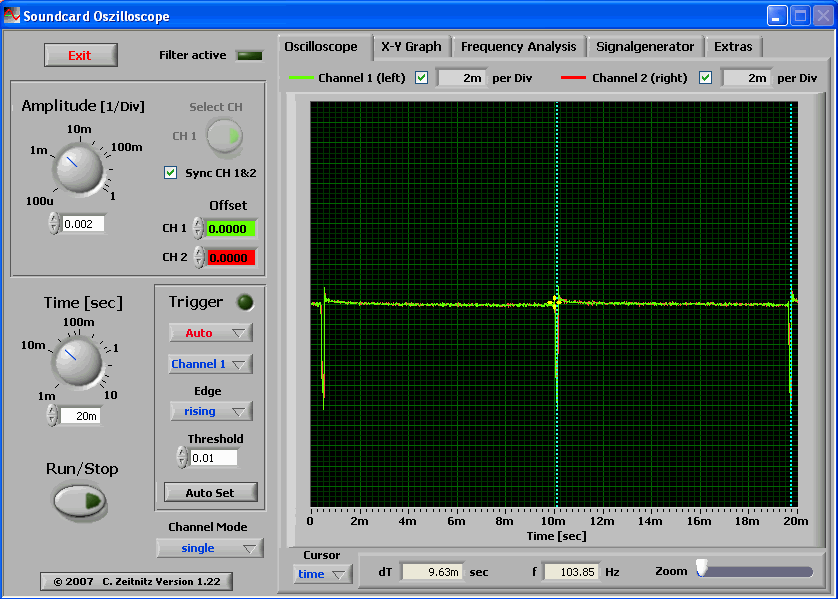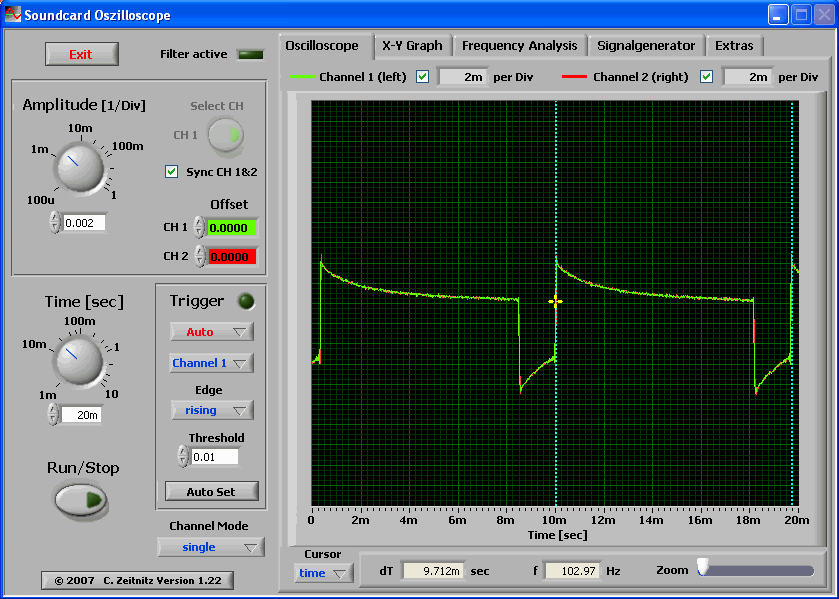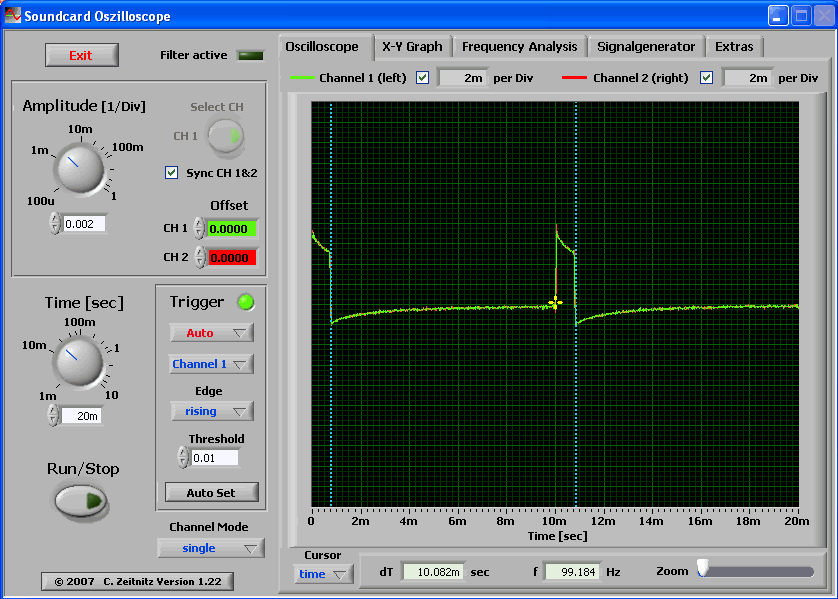Reviewer's Note: The Olight M30 Triton was provided by MattK at batteryjunction.com and Olight.
Warning: very pic heavy, as always
The Olight M30 Triton is the latest Cree MC-E light to cross my review desk.
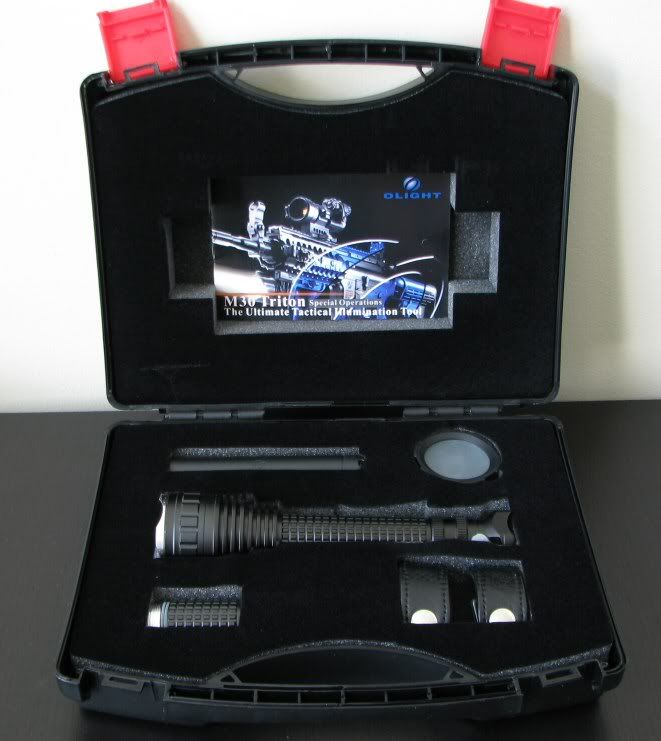
Specs (from the manufacturer):
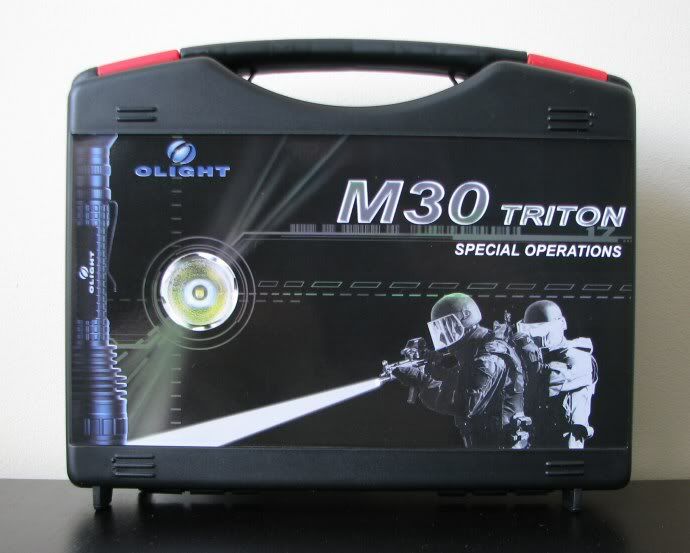
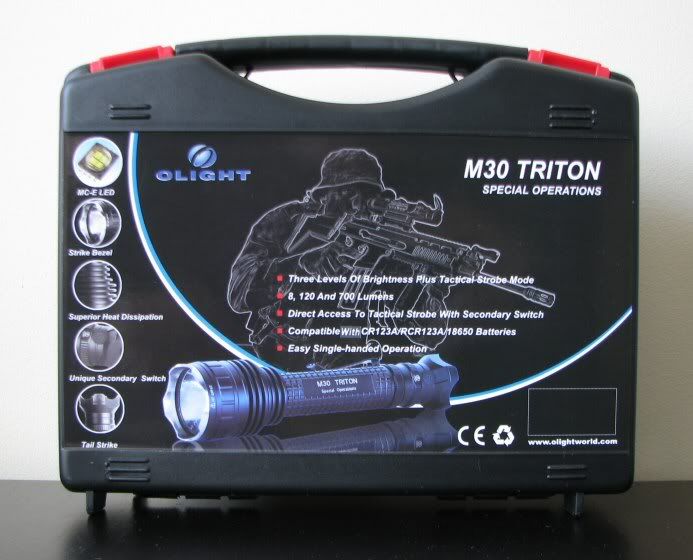
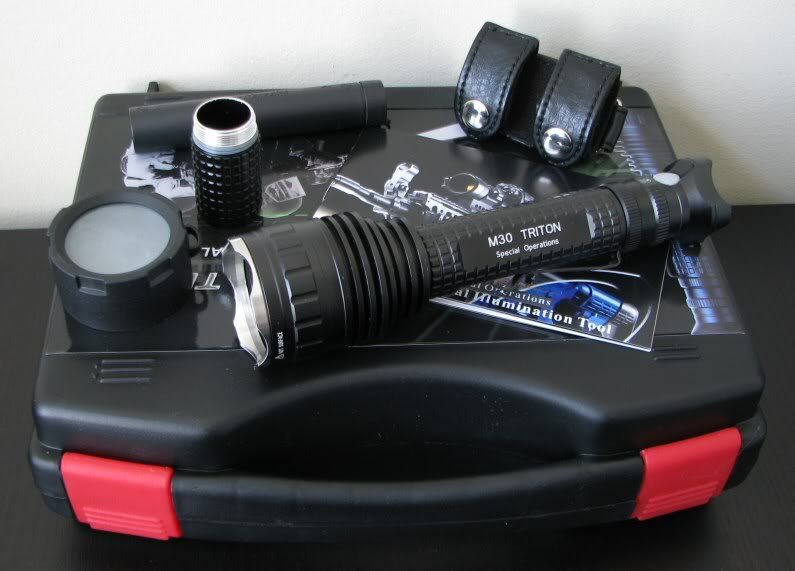
Unlike most of the competition, the M30 Triton comes in a presentation-style case with a lot of extras. :thumbsup: Inside the plastic carrying case, you will find cut-out foam that securely holds the light, battery extender tube, 3xCR123A battery holder, leather belt holster, and instruction manual. No extra o-rings or wrist-strap was included on my sample.
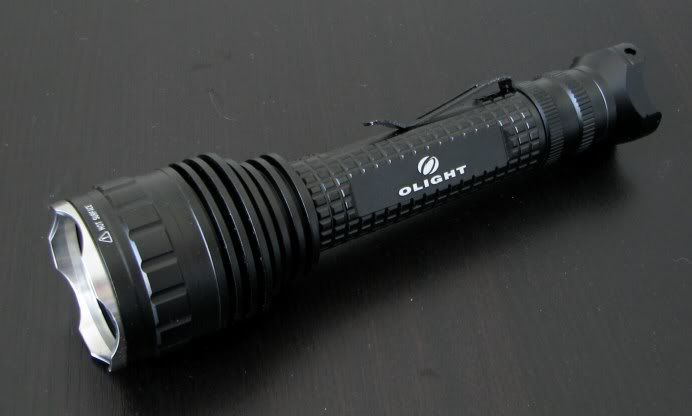
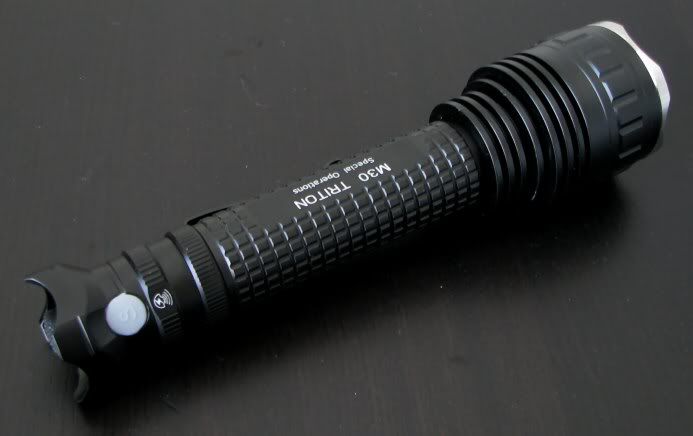
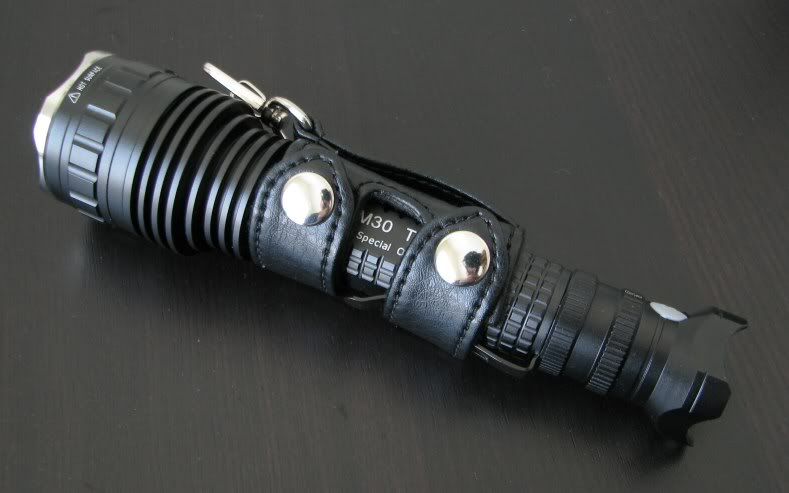
With battery extender in place:
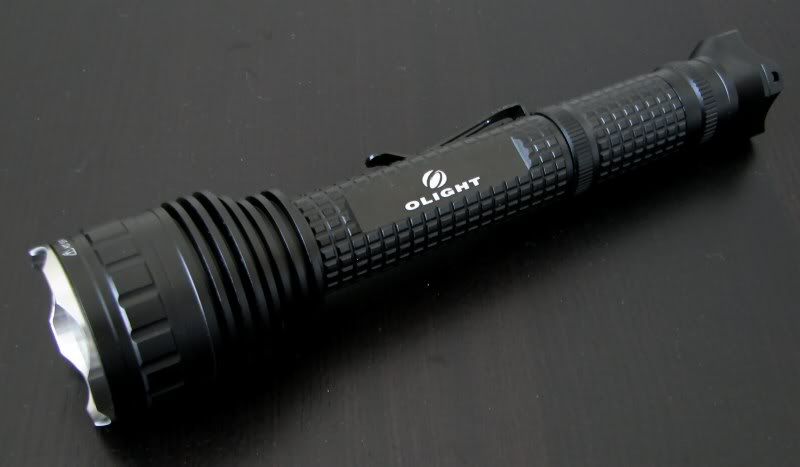
The overall shape and design is similar to other Olight military-series lights. Rather than traditional knurling, the M30 has a raised checkered pattern to help with grip (not as raised as the Tiablo ACE-G). The M30 comes with black finish type-III hard anodizing. I typically find Olight lettering is bright and clear, and the M30 is no exception. Both the bezel opening and tailcap have raised scalloped edges – but unlike the earlier M20, this new M30 can also tailstand.
Note the attached clip can be removed by unscrewing the retaining ring above it and pulling the clip off.
Dimensions (no batteries installed):
Height: 178mm (212mm with battery extender)
Width: 33.0mm (tailcap), 25.1mm (body tube), 42.9mm (bezel)
Weight: 164.0g (no extender), 180.8g (with battery extender)
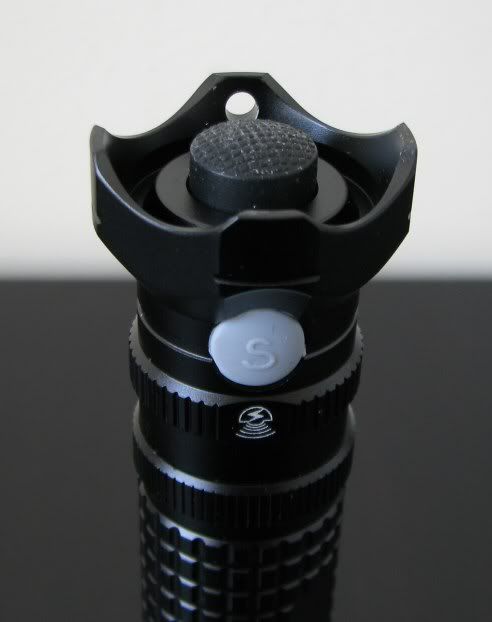
User interface of the M30 is different from other Olights (see below for a discussion). Main activation is controlled by a forward clicky tailcap switch that has a good feel. Even with the raised and flared tailcap edges, I find it easy to access. The innovation of the M30 is the secondary switch on the side of the tailcap (again, see below).
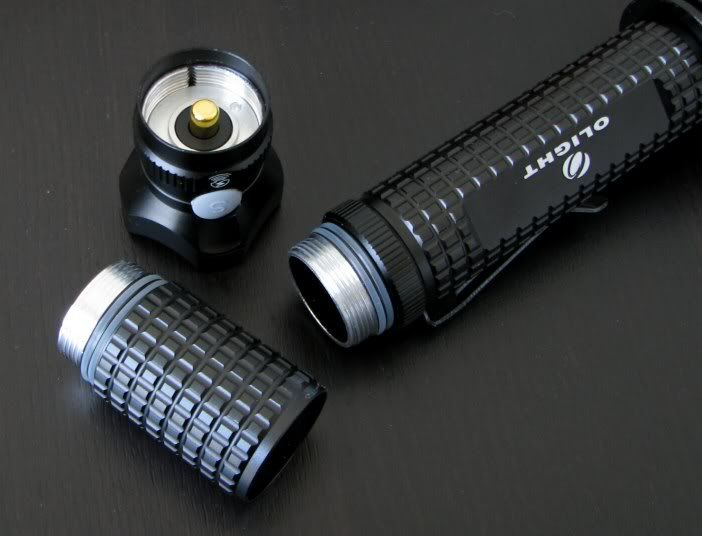
Screw thread action is smooth on all sections, with each component fitting well (note the double o-rings everywhere). My sample seems to have little or no lube, so you may want to add some to increase water resistance. The tailcap switch contact spring has a brass cover over it, but it still retains its spring action.
Unfortunately, the screw threads are not anodized, so there is no tailcap lockout possible. :sigh:
The included 3xCR123A/RCR battery holder is optional – you don't need to use it in this configuration, but it does remove battery rattle if you choose to. The bore width of the body tube is wide enough to accommodate protected 18500/18650, so thinner CR123A cells are prone to some rattle. At the very least, it makes a good storage holder for an extra set of cells.
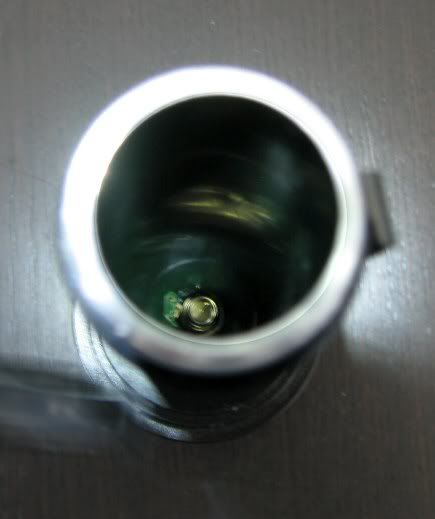
Note the spring in the head, in addition to spring in the tailcap.
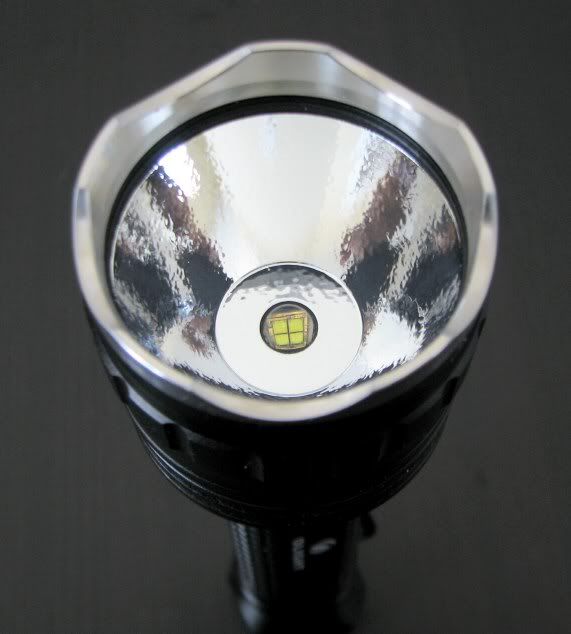
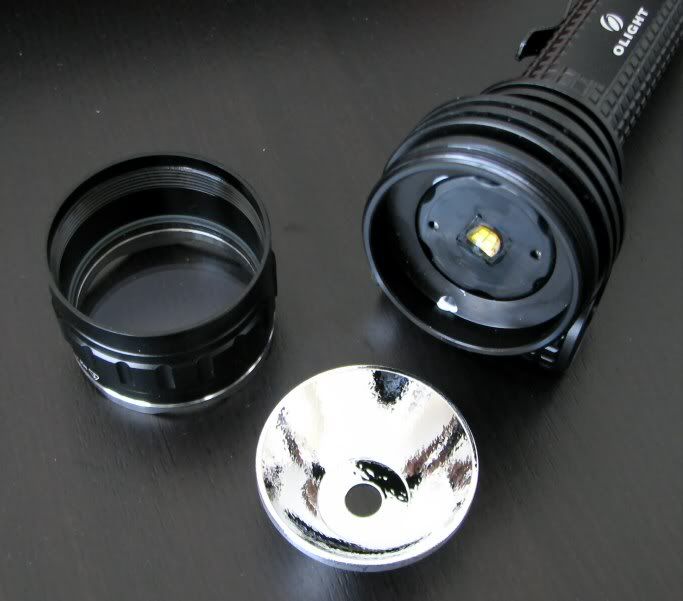
The M30 has a surprisingly small head for a MC-E light, with a shallow reflector with heavy orange peel finish. The M30 is clearly designed to be more of flood-style light than a dedicated thrower, but that is common for MC-E/P7-based lights.
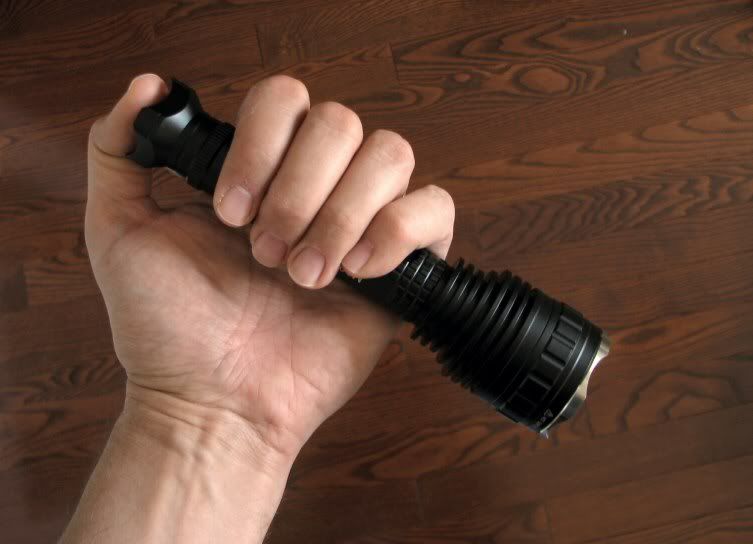
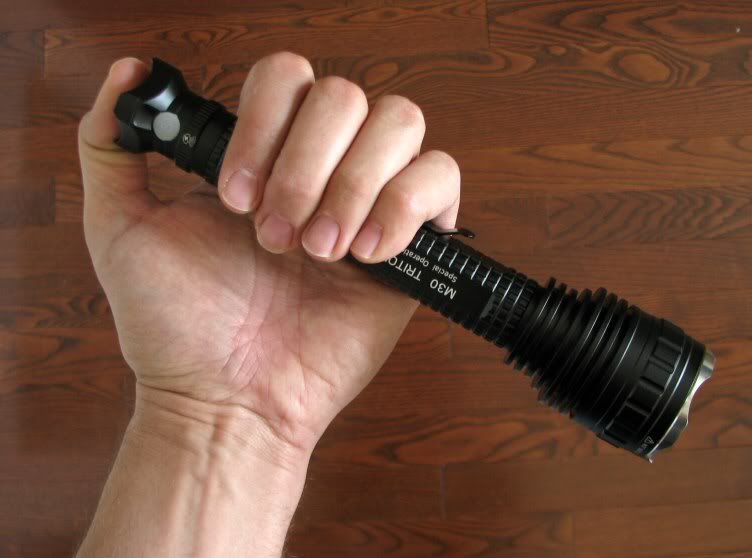
So far, this is probably the most compact and lightest MC-E light I've come across. :thumbsup: In the basic 3xCR123A configuration, this light isn't that much larger than a number of dual-cell lights. But it still feels well made and substantial enough in the hand – I can see it being popular with those looking for a light cannon that doesn't resemble an actual cannon.
Here's how it compares to the competition (with and without battery extenders in place):
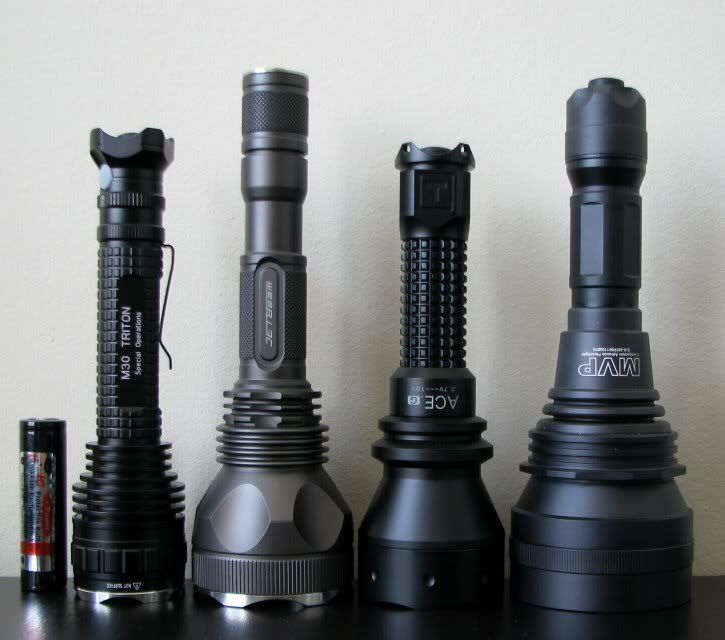
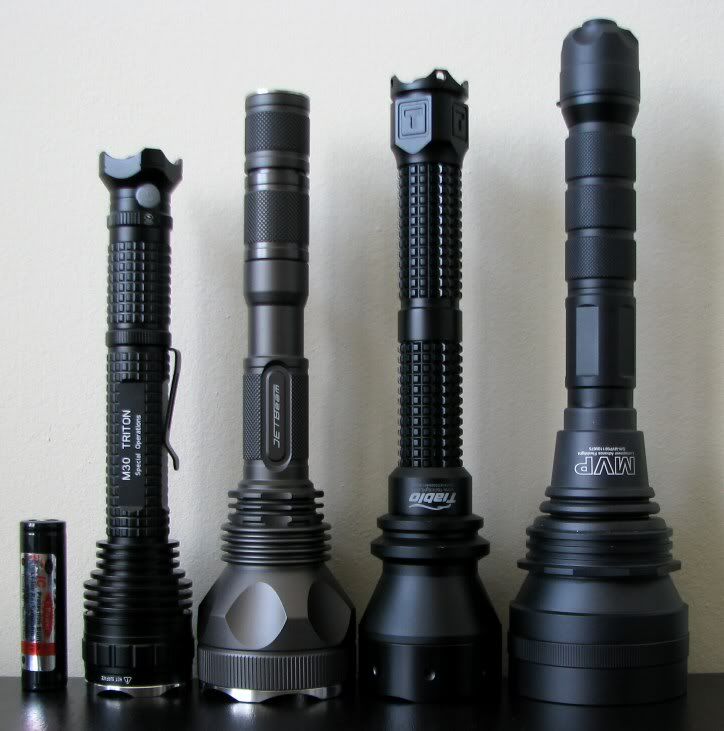
(from left to right, AW 18650 protected battery, Olight M30 Triton, JetBeam M1X, Tiablo ACE-G, Lumapower MVP TurboForce P7).
UPDATE: Here's a bezel shot to better allow you to compare the heads:
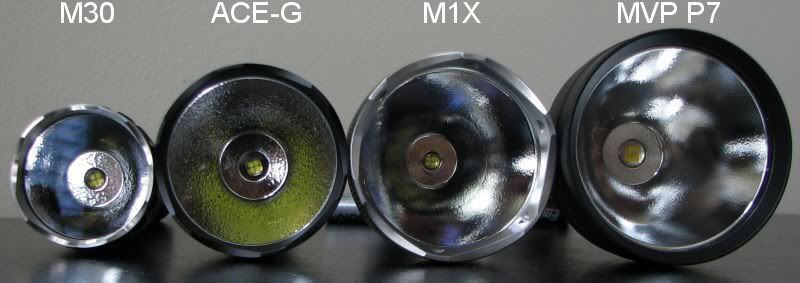
User Interface:
As mentioned above, the M30 features a revised user interface controlled by the primary and secondary tailcap buttons. Press the main tailcap switch for momentary mode, click for lock-on. To change the output mode, press and release the secondary switch (sequence is Lo – Med – Hi – 13Hz Tactical Strobe, in repeating sequence). Interestingly, the light can go directly to strobe from off by pressing and holding the secondary switch. Light has a memory mode to retain the last setting when switching off by the main tailcap switch.
Although not immediately intuitive, this arrangement works well enough when you get used to it. But note that the secondary switch doesn't have much tactile feedback, and doesn't protrude very much from the curve of the tailcap, to prevent accidental activation (I found myself groping around for it on occasion). This will likely make it hard to use if wearing gloves, but at least you aren't likely to accidentally strobe your loved ones in the middle of the night. :laughing:
Like the MC-E-based JetBeam M1X, the M30 uses a base configuration of 3xCR123A/RCR or 2x18500 Li-ion, with a battery extender to allow 4xCR123A or 2x18650 Li-ion (note 4xRCR is not supported). This is a sensible design in my mind, as 2xCR123A/RCR builds typically can't offer full power or full runtime for long (and most don't support 1x18650 – a notable exception being the Tiablo ACE-G).
Aside from the lack of tailcap lockout, my main disappointment thus far with the M30 is the visible pulse-width modulation (PWM). Typically, Olight lights featured highly efficient current-controlled low levels. The M30 is a departure from this tradition, as it uses PWM - and at a very noticeable frequency of 104/103Hz on the Lo/Med modes. :sigh:
The PWM issue is actually a bit more complicated on this light - it uses PWM on the Hi mode as well. This is relatively rare, since most lights set the max output at full power. In this case, you are unlikely to notice it - it doesn't produce a noticeable perceptual flicker because the ON state lasts for the vast majority of the cycle. I don't want the technical details to distract from the main review, so I've posted a more through evaluation of the PWM issue in post #2.
Strobe is indeed at a "tactical" (and highly annoying! ) 13 hz.
) 13 hz.
Comparison Beamshots
All lights are on Max on 2x18650 AW protected Li-ion. Distance is about 0.5 meters from a white wall.
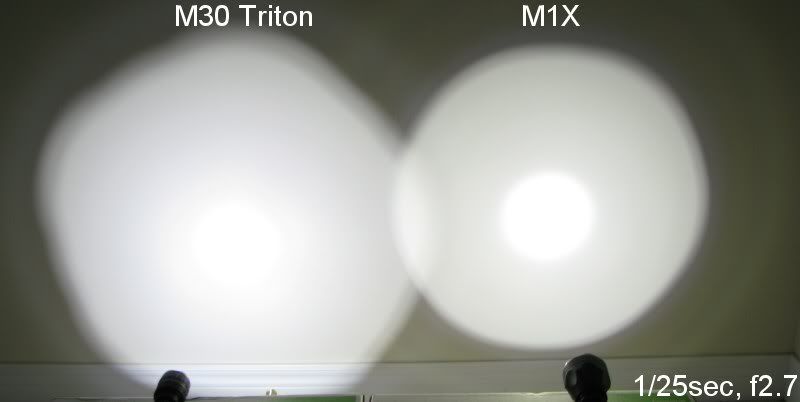
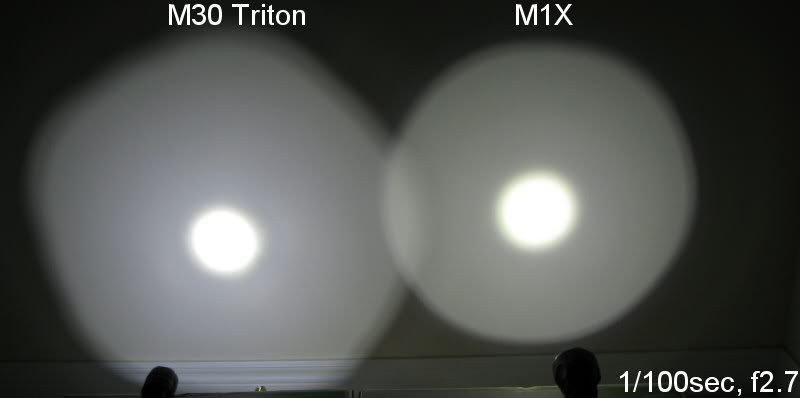
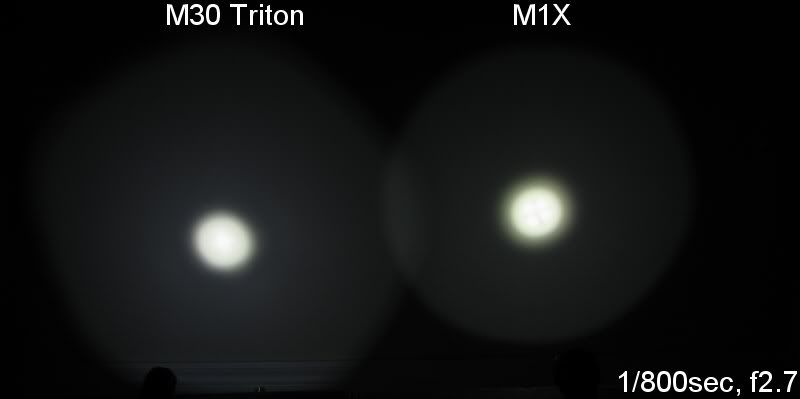
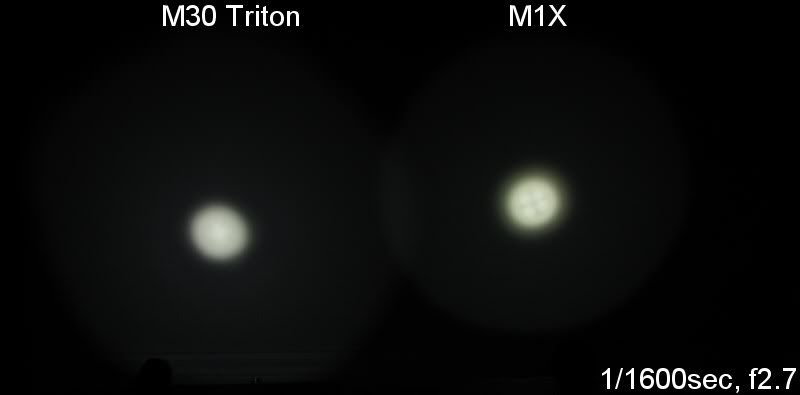
Here's how it looks with the diffuser on:
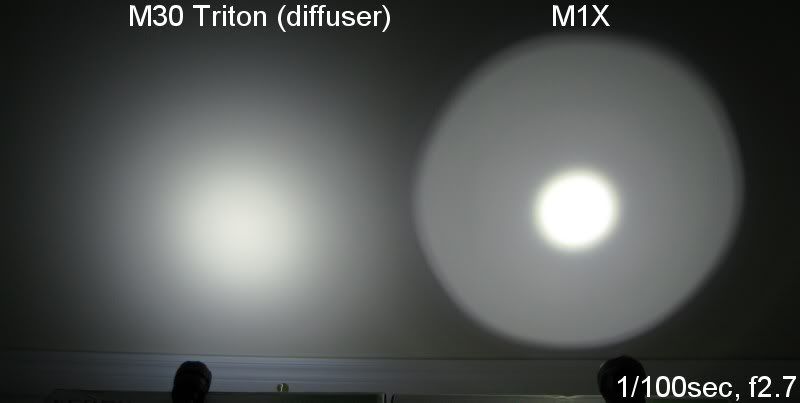
And a few side shots with and without diffuser:
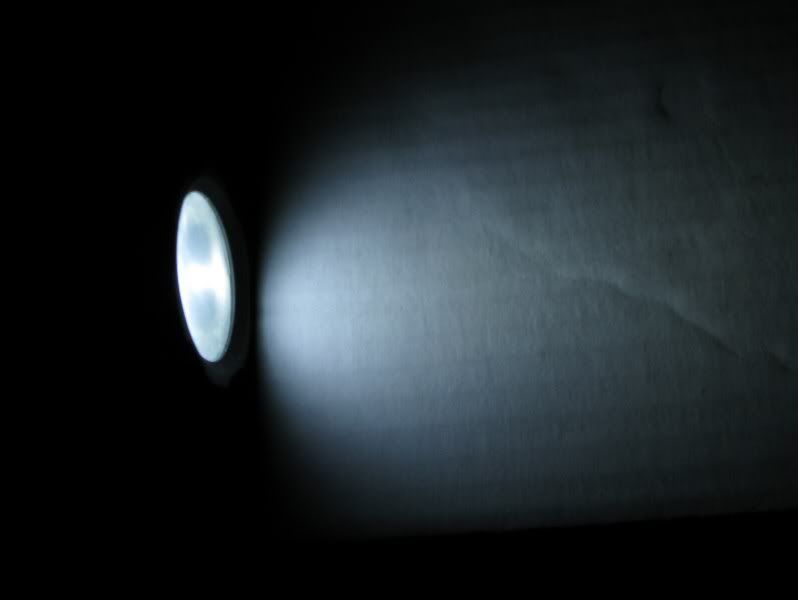
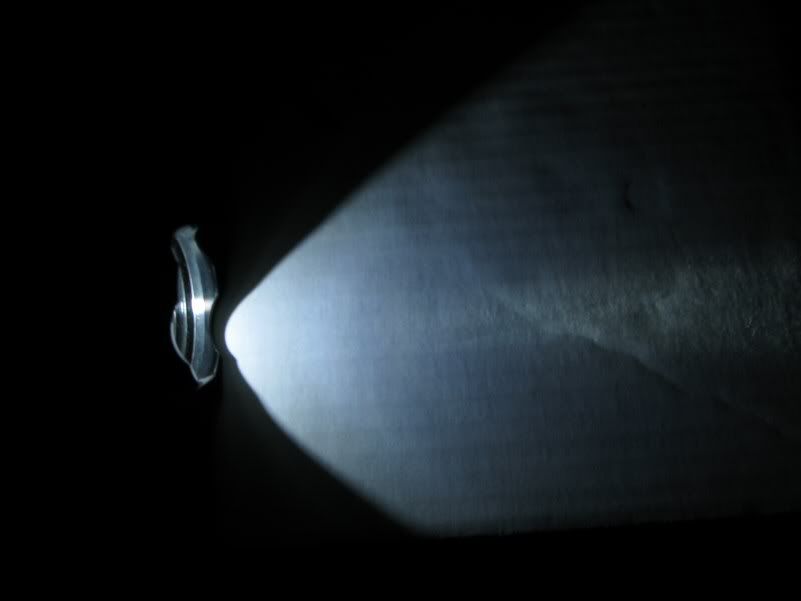
As you can see, the M30 has a fairly typical wide MC-E spillbeam profile (although triangulated somewhat by the removable scalloped bezel ring). Throw is respectable for this class (in comparison, the M1X is a dedicated thrower). Like most MC-E lights, the M30 does have a detectable "donut" hole in the centre beam at greater distances and the "crosshair" pattern up close, but it is not as bad as some. So far, only the Tiablo ACE-G seems to have virtually eliminated this pattern, but the M30 is not overly obtrusive.
Here are some outdoor shots focused on a point ~30 feet from the lights.
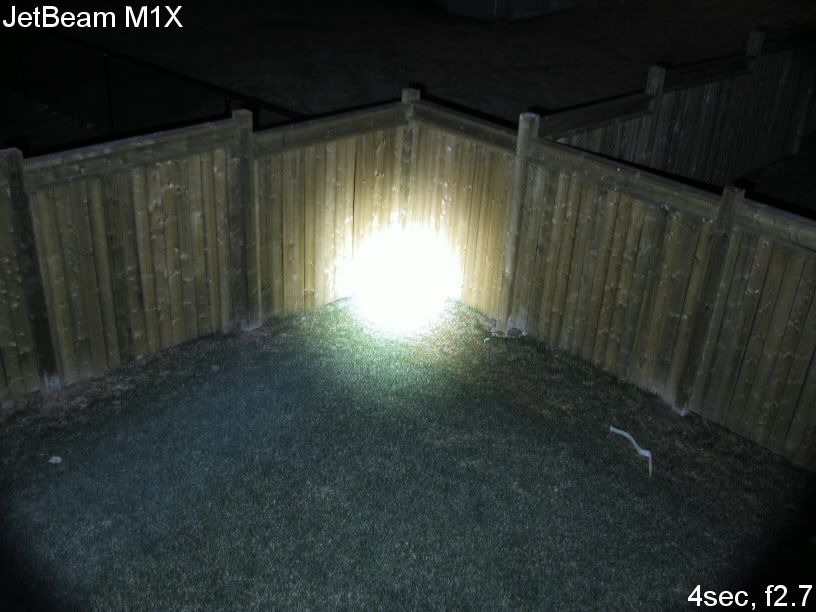
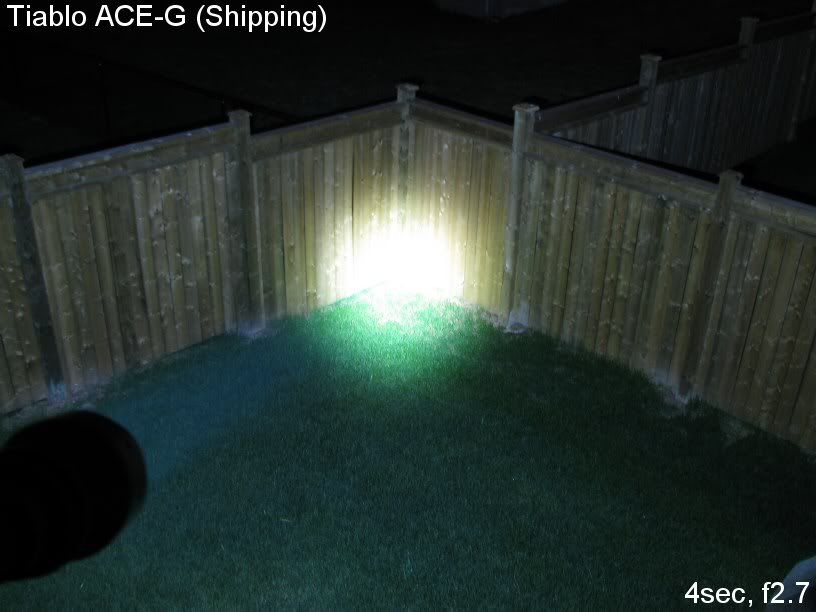
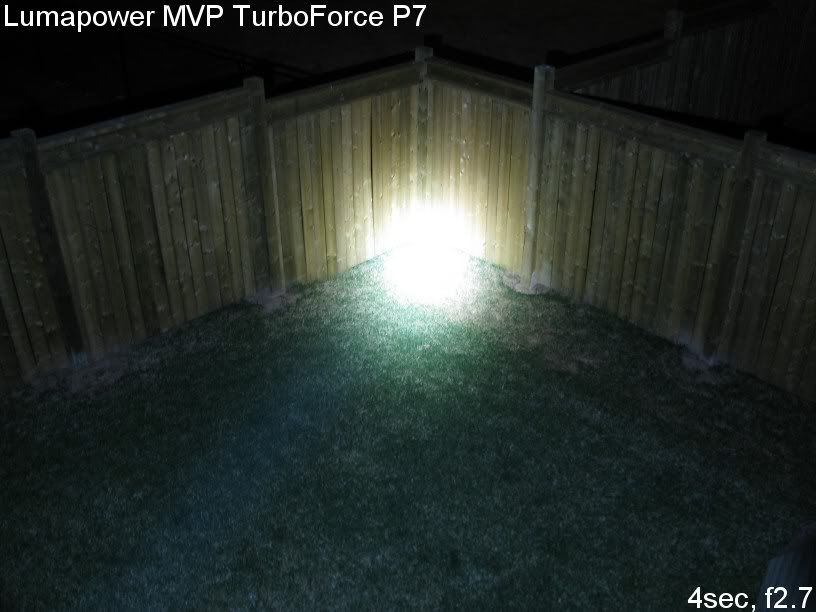
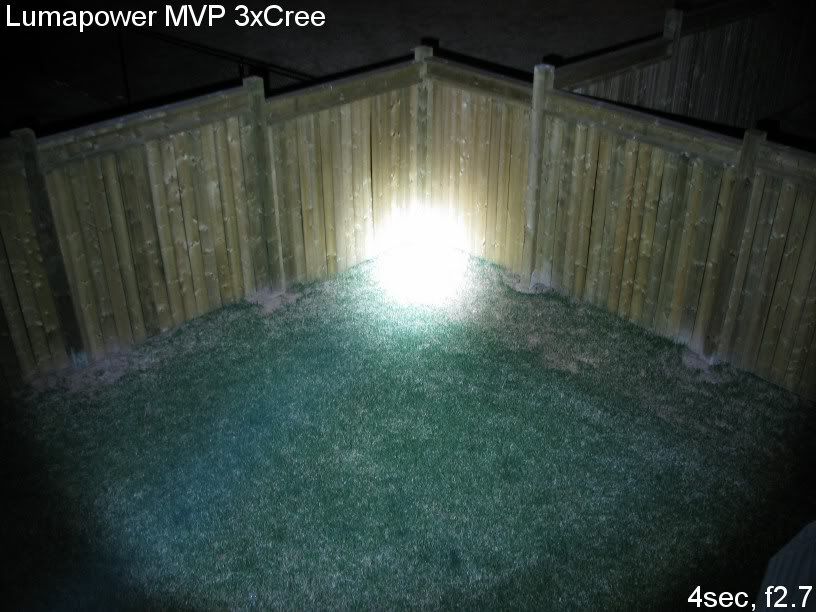
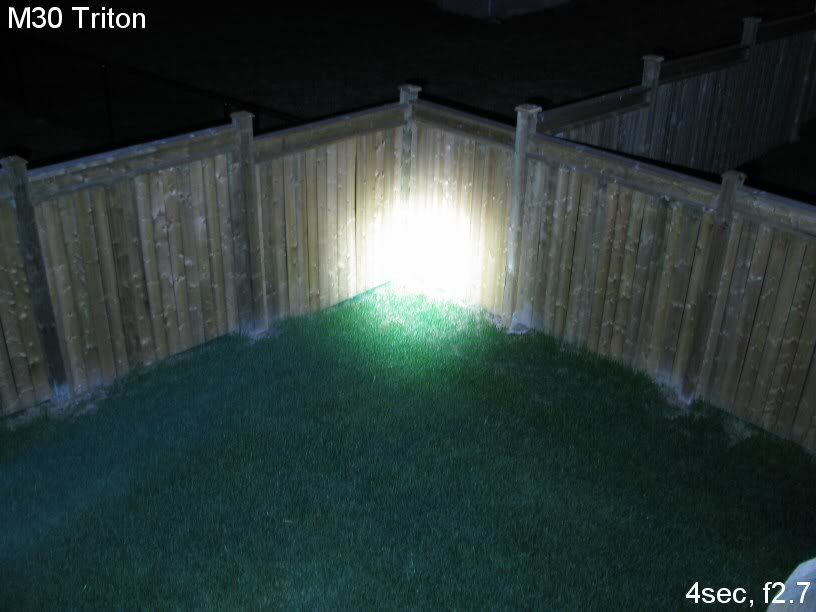
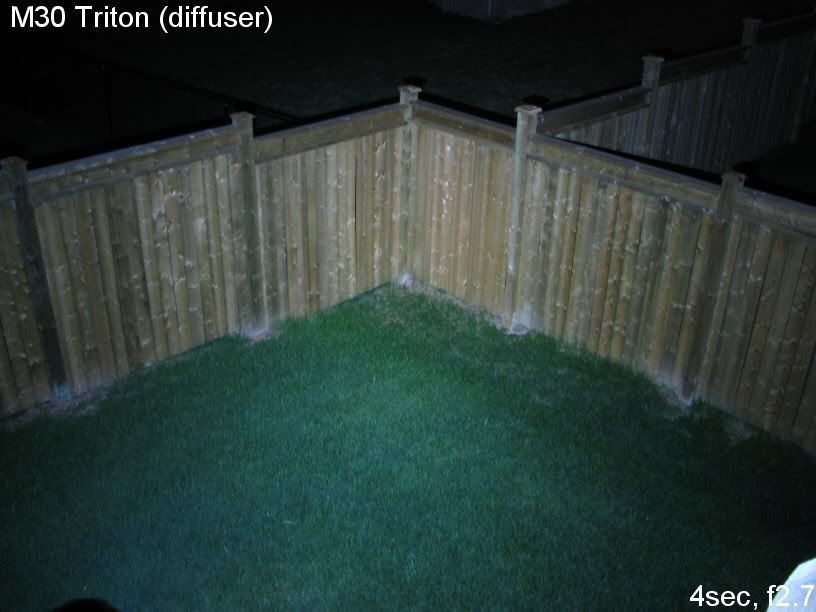
I'm particularly impressed by how well the diffuser spreads out the beam to true flood. :thumbsup:
And here are some lower exposures to better show you the hotspots:
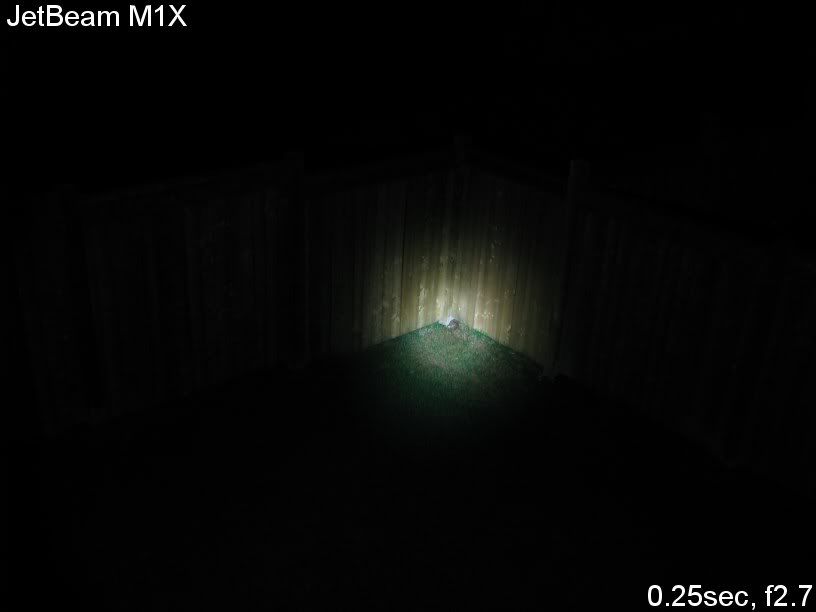
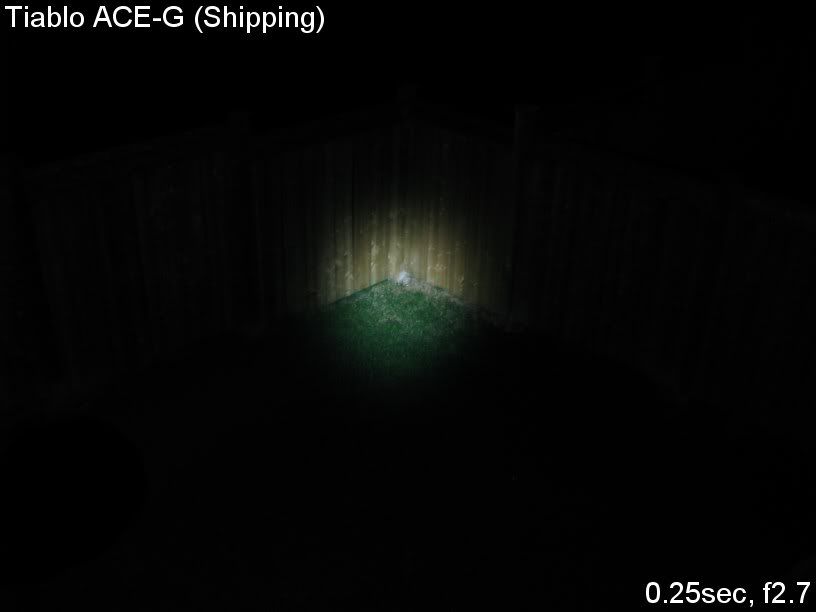
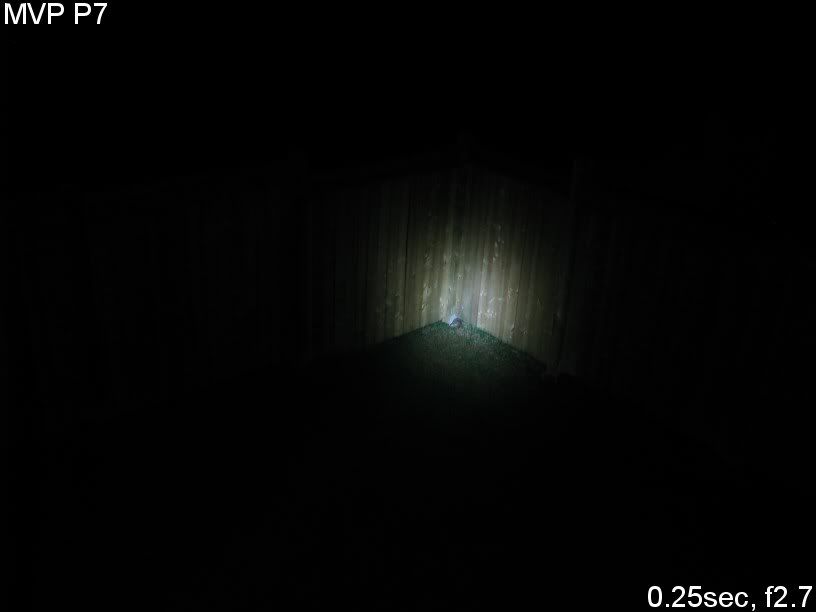
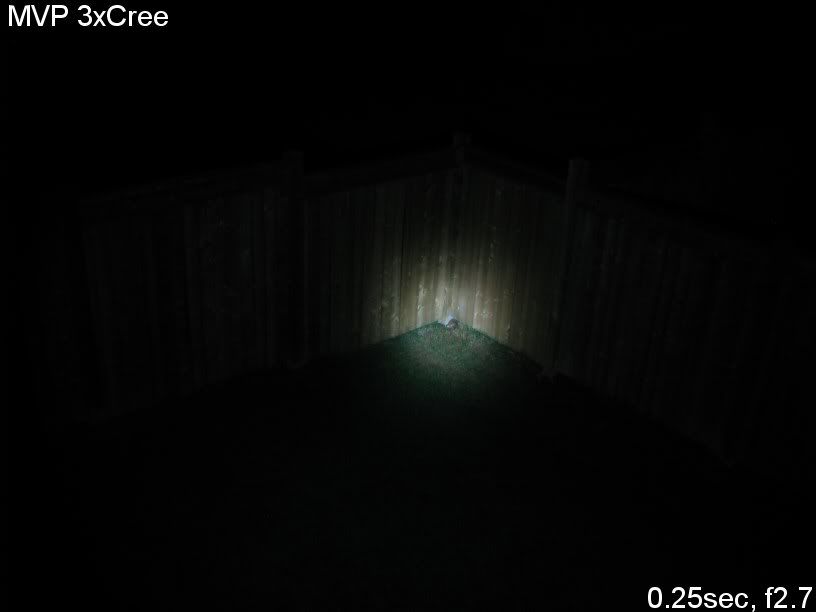
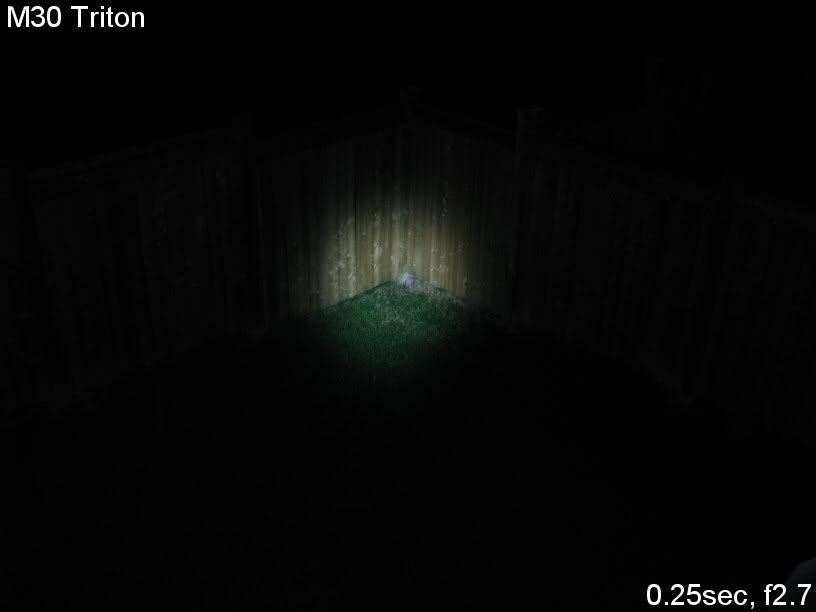
Overall output of the M30 is similar to the JetBeam M1X and revised Tiablo ACE-G (which are in turn brighter than the earlier Lumapower MVP offerings). Beam profile most closely matches the ACE-G, but without as much of a reduction in standard MC-E donut hole effect. The M30 also has the least throw of four lights shown above, but is still quite respectable.
UPDATE: Some additional long-distance beamshots, to show you how the light compares to others in its class.
Please see my recent 100-yard Outdoor Beamshot review for more details (and additional lights).
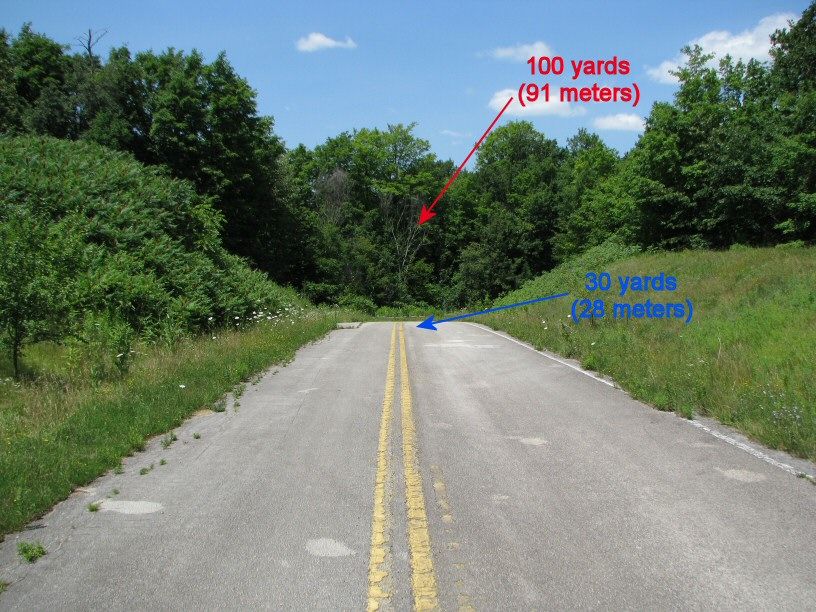
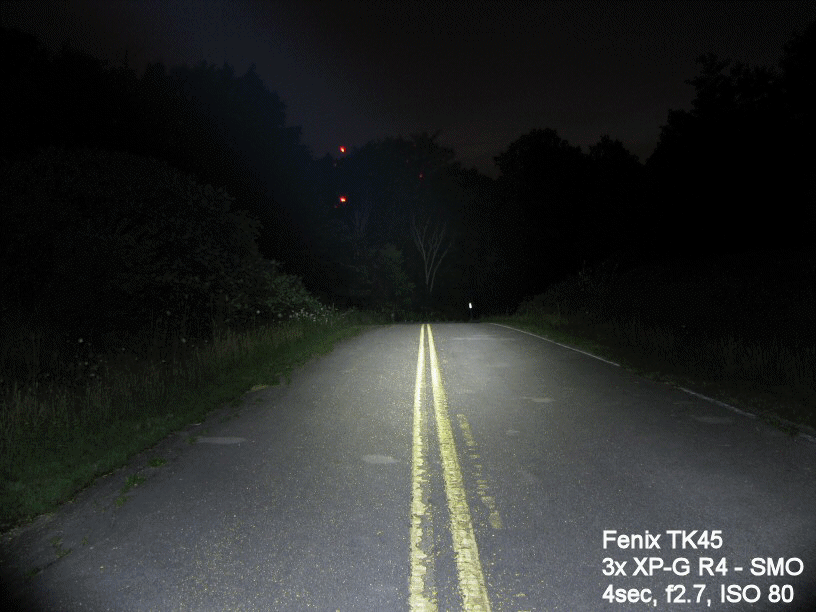
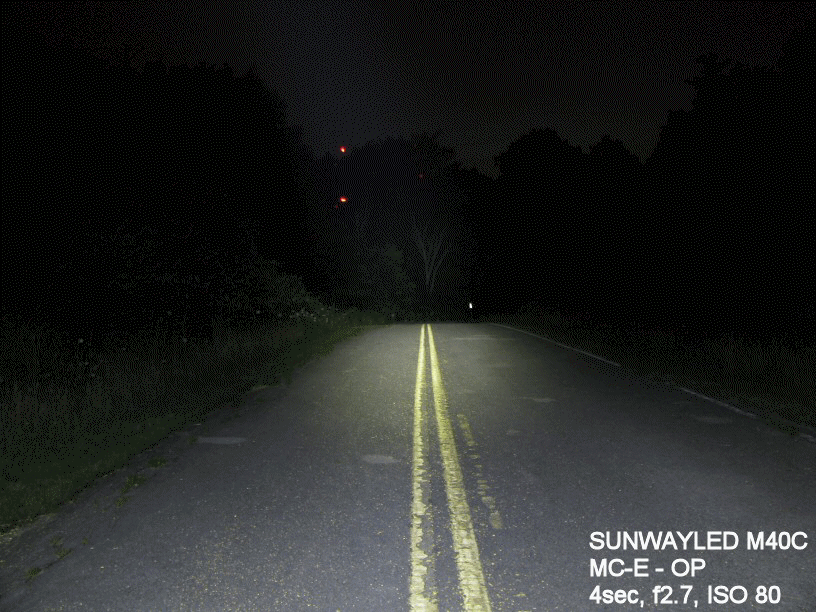
Testing Method: All my output numbers are relative for my home-made light box setup, a la Quickbeam's flashlightreviews.com method. You can directly compare all my relative output values from different reviews - i.e. an output value of "10" in one graph is the same as "10" in another. All runtimes are done under a cooling fan.
Throw values are the square-root of lux measurements taken at 5 meters from the lens, using a light meter, and then extrapolated back to estimate values for 1 meter. This will be my standard way to present throw on these types of lights from now on. The beams don't really have a chance to fully converge until typically several meters out
Some of the MC-E-based lights take a couple of minutes to settle into their regulated output state (i.e. their initial output is higher, but not for long). As such, all my output and throw numbers are taken after 2 mins of continuous runtime (on 2x18650 AW Protected cells).
Throw/Output Summary Chart:
Note that Tiablo has issued a revised ACE-G circuit/pill with much greater output than the pre-production sample I originally reviewed. This shipping version brings the ACE-G in line with the M1X and M30 for overall output. Please see my updated ACE-G/A10-G review for more info.
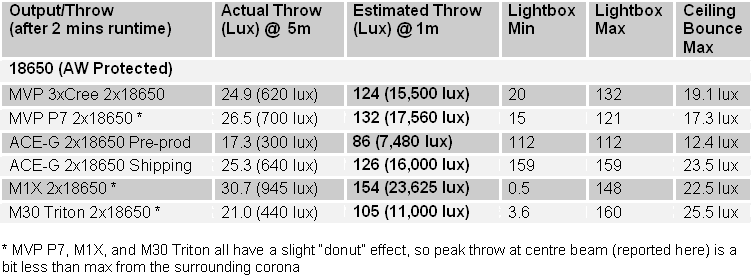
The ceiling bounce and lightbox tests confirm what the beamshots showed – that the Olight M30, JetBeam M1X, and recently revised Tiablo ACE-G all have roughly equivalent max output (although the M30 has technically a slight edge on my ceiling bounce). :thumbsup: Consistent with the smaller and shallower reflector, throw on the M30 is lowest of the class – but still quite respectable.
Output/Runtime Comparison
I've identified the output levels for the Med/Lo on the runtime chart below. They are both a bit lower than typical for this class of light (although may suit your personal preference).
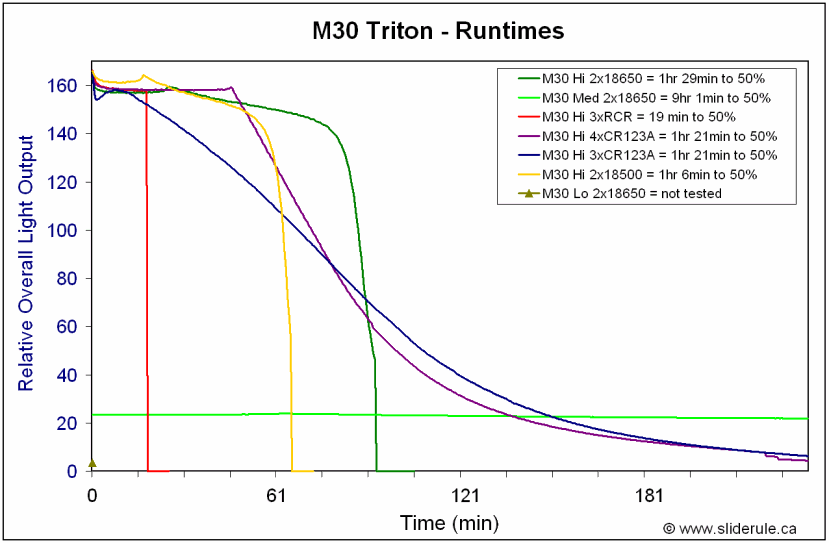
I don't generally do 4xCR123A tests, but results on the other battery sources match my expectations. Note my 3xRCR runtimes are likely on the low side – I suspect all the recent high drain runs on these cells have reduced their charge-storing capacity.
UPDATE 06/08/09: I've just updated the graphs with 4xCR123A runtimes for all lights that support this configuration. Also included are some recent additions to the multi-emitter class that I have recently reviewed.
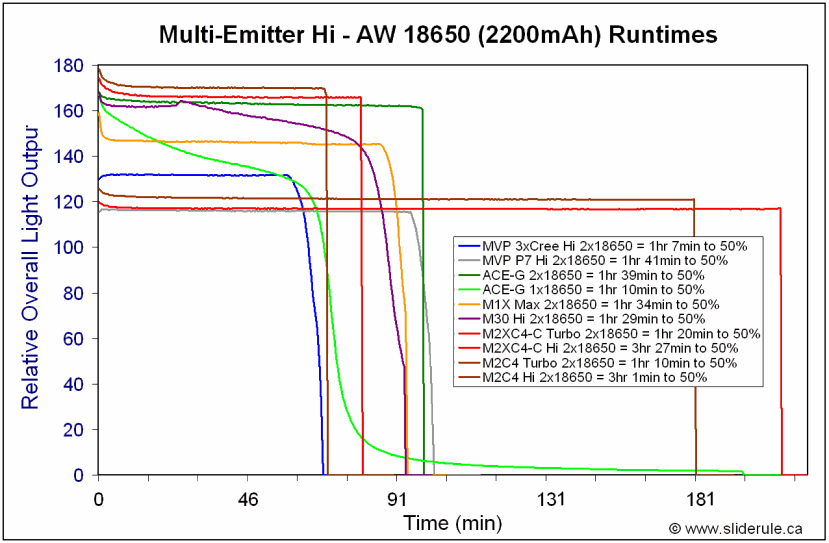
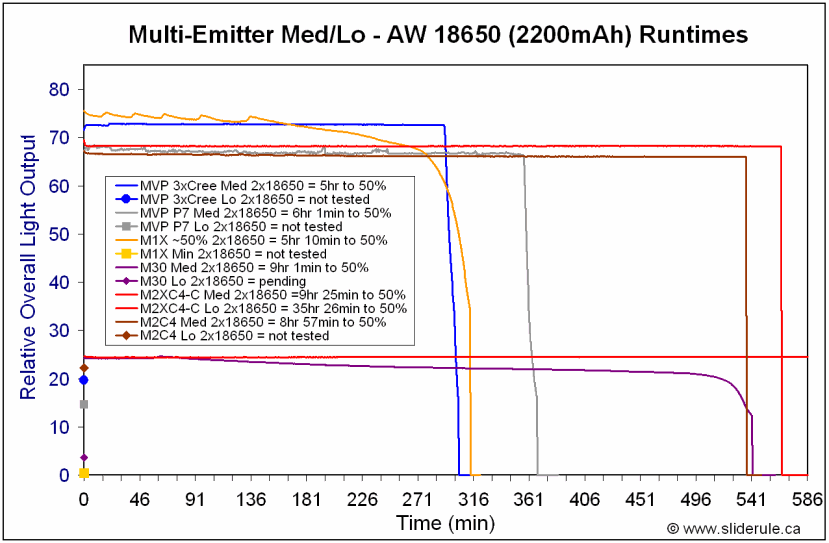
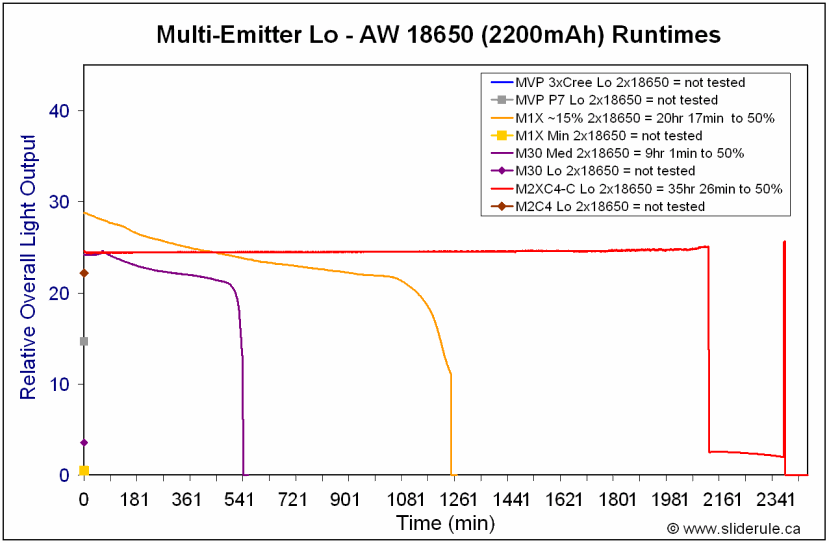
The M30 puts out an impressive amount of light on Max – equivalent to the single-stage Tiablo ACE-G (with revised shipping circuit).
On Med, the 2x18650 battery tests are consistent with Olight's published specs, although it is less than I would have expected for the output level (i.e. runtime is much less than some of the competition at this level).
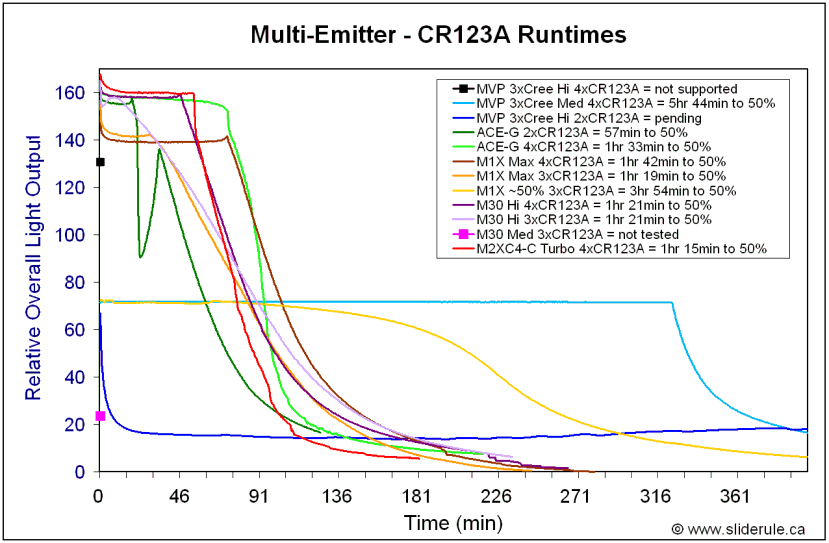
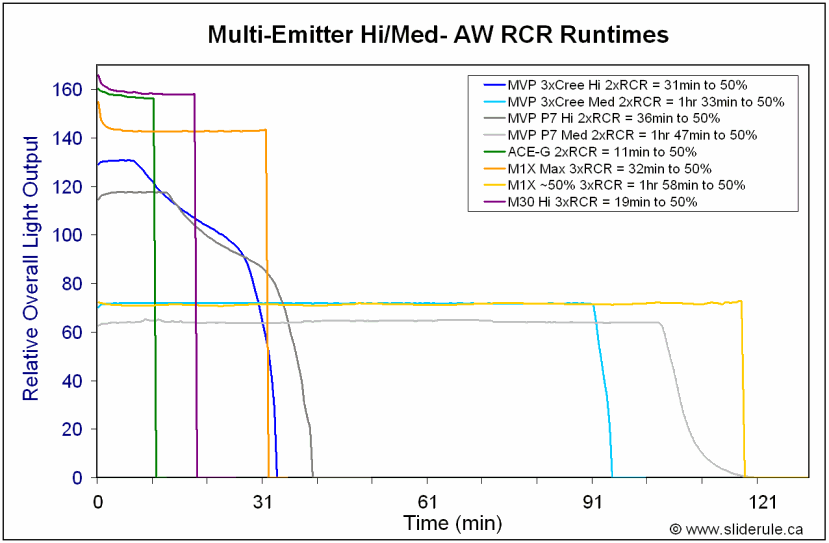
No real surprises here: on 3-cell configurations, Max performance is close to the M1X.
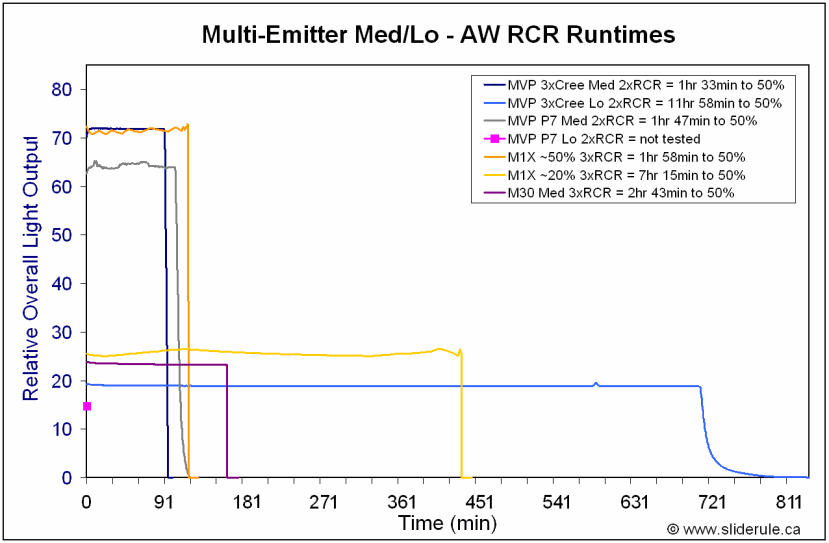
The efficiency of the Med performance of the M30 (which is equivalent to the Lo of Lumapower lights) is definitely lower than the competition. As you can see above, the M30 runtime is much less than the M1X when matched for output, which is a bit disappointing given the defined output levels of the M30 (the M1X is continuously variable). I haven't done Lo mode runtimes on the MVP P7, but you can easily see here the benefit that current-control circuitry brings to runtime efficiency by looking at the MVP 3xCree. And note the Lumapower is only on 2xRCR compared the 3xRCR for the M1X and M30. oo:
oo:
As always, there is lot more than just output/runtime efficiency to consider when choosing a light. But typically, I think most users look for greater efficiency in defined-output level lights compared to continuously-variable ones.
Potential Issues
Detectable ~100Hz PWM on all output modes, very noticeable on Lo/Med levels.
Light has the typical M-CE centre-beam "donut" effect, although not as bad as some of the earlier MC-E/P7 lights.
User interface is unusual and may take some getting used to. You may have difficulty in finding/accessing the secondary switch to change modes when wearing gloves.
Lo/Med modes are lower than typical for this class of light, and runtime efficiency is lower than the competition that offers matching output.
Preliminary Observations
The Olight M30 Triton has a very nice build and presentation package, IMO. With all the new M-CE "searchlights" coming out, I've been a bit disappointed to see the somewhat standard set of extras most manufacturers are bundling with them (i.e. standard shipping box, thin wrist lanyard, etc.) Given the size of most of these lights, you are going to want a better way to carry it around with you. The M30 carrying case is exactly the kind of thing I would like to see everyone provide. :thumbsup:
Given the size of most of these lights, you are going to want a better way to carry it around with you. The M30 carrying case is exactly the kind of thing I would like to see everyone provide. :thumbsup:
The extras are also particularly welcome – it nice to see the belt loop and well-fitting diffuser tip. Even the optional battery holder is useful for carrying around extra cells. I am happy to commend Olight on their foresight on this issue (although extra o-rings should probably be standard as well).
In terms of build, I was (pleasantly) surprised by the relatively small size of the M30. In its base 3xCR123A/RCR build, it is not that much bigger than a number of standard dual-cell lights. Despite the smaller size, construction still feels solid and well-made – I have no doubt this will be another durable offering from Olight. Tailcap screw thread anodizing would be a nice feature, though.
I haven't quite made up my mind about the interface. I personally liked the dual twist/click design of the M20, even though it required two hands to switch modes. The M30's secondary switch means you now can access all features one-handed, but I have found the lack of obvious tactile feel means that I often have to look down at the light to see where the button is (although the flat area on the ring below is actually helpful for guiding your finger to the right spot). The flip-side is don't have to worry about accidentally changing modes too easily. :shrug: And the light has a memory feature, so it will retain the last setting use (i.e. you could set as a standard single output and not worry about it).
My only real disappointment with this light is the visible PWM on the Lo/Med modes. I find ~100 Hz to be *very* distracting in actual use, especially at really low levels. It make me feel quite :green:. Honestly, I can't really see myself using either the Lo or Med mode for this reason, which is very disappointing. I strongly urge Olight to find a way to get that PWM up to a higher frequency that is not visible. (UPDATE: Given the Med mode runtime results, I would also like to see increased output/runtime efficiency for the M30).
But to put things in perspective, the M30's output/runtime performance on Hi (where is PWM is not generally noticeable) is very close to the single-stage-only Tiablo ACE-G. The M30 reflector is also very decent for a MC-E light, although still has a bit of the standard MC-E donut (the ACE-G is the best I've seen at minimizing this). As always, it comes down to what feature set and design elements you are looking for in a light (e.g. the M30 was primarily designed for tactical use). All lights have trade-offs, and I suggest you compare the features of the M30 to the other MC-E lights I have reviewed recently (I plan to do a round-up review eventually once a few more MC-E lights come in for testing ).
).
In the meantime, I can say the M30 is the smallest and lightest of all the recent MC-E lights I have tested, with a quality build in a good package with excellent accessories. Although there are a few oversights (e.g. lack of extra o-rings and lube, no tailcap lock-out), there are also a lot of thoughtful little touches (e.g. the cover retaining ring over the attached clip, included quality diffuser, etc.), along with some unique design elements (e.g. secondary switch) and a range of outputs and an easily-accessed tactical strobe. It is also one of the more attractively priced MC-E offerings in the quality brand-name space, especially considering the bundled extras.
If Olight could just ramp up the PWM to an undetectable frequency - and increase the output/runtime efficiency on Med - then I think this light could serve well as a jack-of-all-trades.
UPDATE June 13, 2009: After playing with all my MC-E lights a little more, I have to say the M30 is growing on me. I quite like the smaller form factor in 2x18500/3xCR123A, as it is not that much bigger or bulkier than a standard 2xCR123A. Some of the other MC-E competition can be a bit difficult to carry. And the spacing of the levels is pretty good in actual use, even if their relative runtime performance is less than the competition. I also like the included diffuser. If the PWM on Lo/Med doesn't bother you (and I still personally think that is a big IF), then this is probably one of the better candidates for an everyday duty/carry light in the MC-E class.
Warning: very pic heavy, as always
The Olight M30 Triton is the latest Cree MC-E light to cross my review desk.

Specs (from the manufacturer):
- Cree MC-E LED
- Max 700 lumens on Hi, 1.5 hours
- Medium Mode 120 lumens, 7.5hours,
- Low Mode 8 lumens, 90hours
- Strobe 700 lumens, 1.5hours
- Side switch on tail cap for direct access to strobe from power-off and changing modes from power-on
- Front & Rear removable strike bezel
- Full orange peel reflector
- Rugged aluminum body with type III hard anodization
- Water resistant to IP68
- Shatter-resistant ultra clear lens, anti-scratching and anti-slip
- Built-in stainless steel pocket clip
- Battery Options in 3 Cell config: 3xCR123A/RCR123A batteries or 2x18500 li-Ion.
- Battery Options in 4 Cell config w/included extender tube: 4xCR123A or 2x 18650 Li-ion
- Dimension 43.5mm/1.71"(D) X 176.9mm/6.96"(L)
- Dimension with extender tube 43.5mm/1.71"(D) X 210.9mm/8.3"(L)
- Weight: 165.2g/5.83oz (excludes battery)



Unlike most of the competition, the M30 Triton comes in a presentation-style case with a lot of extras. :thumbsup: Inside the plastic carrying case, you will find cut-out foam that securely holds the light, battery extender tube, 3xCR123A battery holder, leather belt holster, and instruction manual. No extra o-rings or wrist-strap was included on my sample.



With battery extender in place:

The overall shape and design is similar to other Olight military-series lights. Rather than traditional knurling, the M30 has a raised checkered pattern to help with grip (not as raised as the Tiablo ACE-G). The M30 comes with black finish type-III hard anodizing. I typically find Olight lettering is bright and clear, and the M30 is no exception. Both the bezel opening and tailcap have raised scalloped edges – but unlike the earlier M20, this new M30 can also tailstand.
Note the attached clip can be removed by unscrewing the retaining ring above it and pulling the clip off.
Dimensions (no batteries installed):
Height: 178mm (212mm with battery extender)
Width: 33.0mm (tailcap), 25.1mm (body tube), 42.9mm (bezel)
Weight: 164.0g (no extender), 180.8g (with battery extender)

User interface of the M30 is different from other Olights (see below for a discussion). Main activation is controlled by a forward clicky tailcap switch that has a good feel. Even with the raised and flared tailcap edges, I find it easy to access. The innovation of the M30 is the secondary switch on the side of the tailcap (again, see below).

Screw thread action is smooth on all sections, with each component fitting well (note the double o-rings everywhere). My sample seems to have little or no lube, so you may want to add some to increase water resistance. The tailcap switch contact spring has a brass cover over it, but it still retains its spring action.
Unfortunately, the screw threads are not anodized, so there is no tailcap lockout possible. :sigh:
The included 3xCR123A/RCR battery holder is optional – you don't need to use it in this configuration, but it does remove battery rattle if you choose to. The bore width of the body tube is wide enough to accommodate protected 18500/18650, so thinner CR123A cells are prone to some rattle. At the very least, it makes a good storage holder for an extra set of cells.

Note the spring in the head, in addition to spring in the tailcap.


The M30 has a surprisingly small head for a MC-E light, with a shallow reflector with heavy orange peel finish. The M30 is clearly designed to be more of flood-style light than a dedicated thrower, but that is common for MC-E/P7-based lights.


So far, this is probably the most compact and lightest MC-E light I've come across. :thumbsup: In the basic 3xCR123A configuration, this light isn't that much larger than a number of dual-cell lights. But it still feels well made and substantial enough in the hand – I can see it being popular with those looking for a light cannon that doesn't resemble an actual cannon.
Here's how it compares to the competition (with and without battery extenders in place):


(from left to right, AW 18650 protected battery, Olight M30 Triton, JetBeam M1X, Tiablo ACE-G, Lumapower MVP TurboForce P7).
UPDATE: Here's a bezel shot to better allow you to compare the heads:

User Interface:
As mentioned above, the M30 features a revised user interface controlled by the primary and secondary tailcap buttons. Press the main tailcap switch for momentary mode, click for lock-on. To change the output mode, press and release the secondary switch (sequence is Lo – Med – Hi – 13Hz Tactical Strobe, in repeating sequence). Interestingly, the light can go directly to strobe from off by pressing and holding the secondary switch. Light has a memory mode to retain the last setting when switching off by the main tailcap switch.
Although not immediately intuitive, this arrangement works well enough when you get used to it. But note that the secondary switch doesn't have much tactile feedback, and doesn't protrude very much from the curve of the tailcap, to prevent accidental activation (I found myself groping around for it on occasion). This will likely make it hard to use if wearing gloves, but at least you aren't likely to accidentally strobe your loved ones in the middle of the night. :laughing:
Like the MC-E-based JetBeam M1X, the M30 uses a base configuration of 3xCR123A/RCR or 2x18500 Li-ion, with a battery extender to allow 4xCR123A or 2x18650 Li-ion (note 4xRCR is not supported). This is a sensible design in my mind, as 2xCR123A/RCR builds typically can't offer full power or full runtime for long (and most don't support 1x18650 – a notable exception being the Tiablo ACE-G).
Aside from the lack of tailcap lockout, my main disappointment thus far with the M30 is the visible pulse-width modulation (PWM). Typically, Olight lights featured highly efficient current-controlled low levels. The M30 is a departure from this tradition, as it uses PWM - and at a very noticeable frequency of 104/103Hz on the Lo/Med modes. :sigh:
The PWM issue is actually a bit more complicated on this light - it uses PWM on the Hi mode as well. This is relatively rare, since most lights set the max output at full power. In this case, you are unlikely to notice it - it doesn't produce a noticeable perceptual flicker because the ON state lasts for the vast majority of the cycle. I don't want the technical details to distract from the main review, so I've posted a more through evaluation of the PWM issue in post #2.
Strobe is indeed at a "tactical" (and highly annoying!
Comparison Beamshots
All lights are on Max on 2x18650 AW protected Li-ion. Distance is about 0.5 meters from a white wall.




Here's how it looks with the diffuser on:

And a few side shots with and without diffuser:


As you can see, the M30 has a fairly typical wide MC-E spillbeam profile (although triangulated somewhat by the removable scalloped bezel ring). Throw is respectable for this class (in comparison, the M1X is a dedicated thrower). Like most MC-E lights, the M30 does have a detectable "donut" hole in the centre beam at greater distances and the "crosshair" pattern up close, but it is not as bad as some. So far, only the Tiablo ACE-G seems to have virtually eliminated this pattern, but the M30 is not overly obtrusive.
Here are some outdoor shots focused on a point ~30 feet from the lights.






I'm particularly impressed by how well the diffuser spreads out the beam to true flood. :thumbsup:
And here are some lower exposures to better show you the hotspots:





Overall output of the M30 is similar to the JetBeam M1X and revised Tiablo ACE-G (which are in turn brighter than the earlier Lumapower MVP offerings). Beam profile most closely matches the ACE-G, but without as much of a reduction in standard MC-E donut hole effect. The M30 also has the least throw of four lights shown above, but is still quite respectable.
UPDATE: Some additional long-distance beamshots, to show you how the light compares to others in its class.
Please see my recent 100-yard Outdoor Beamshot review for more details (and additional lights).



Testing Method: All my output numbers are relative for my home-made light box setup, a la Quickbeam's flashlightreviews.com method. You can directly compare all my relative output values from different reviews - i.e. an output value of "10" in one graph is the same as "10" in another. All runtimes are done under a cooling fan.
Throw values are the square-root of lux measurements taken at 5 meters from the lens, using a light meter, and then extrapolated back to estimate values for 1 meter. This will be my standard way to present throw on these types of lights from now on. The beams don't really have a chance to fully converge until typically several meters out
Some of the MC-E-based lights take a couple of minutes to settle into their regulated output state (i.e. their initial output is higher, but not for long). As such, all my output and throw numbers are taken after 2 mins of continuous runtime (on 2x18650 AW Protected cells).
Throw/Output Summary Chart:
Note that Tiablo has issued a revised ACE-G circuit/pill with much greater output than the pre-production sample I originally reviewed. This shipping version brings the ACE-G in line with the M1X and M30 for overall output. Please see my updated ACE-G/A10-G review for more info.

The ceiling bounce and lightbox tests confirm what the beamshots showed – that the Olight M30, JetBeam M1X, and recently revised Tiablo ACE-G all have roughly equivalent max output (although the M30 has technically a slight edge on my ceiling bounce). :thumbsup: Consistent with the smaller and shallower reflector, throw on the M30 is lowest of the class – but still quite respectable.
Output/Runtime Comparison
I've identified the output levels for the Med/Lo on the runtime chart below. They are both a bit lower than typical for this class of light (although may suit your personal preference).

I don't generally do 4xCR123A tests, but results on the other battery sources match my expectations. Note my 3xRCR runtimes are likely on the low side – I suspect all the recent high drain runs on these cells have reduced their charge-storing capacity.
UPDATE 06/08/09: I've just updated the graphs with 4xCR123A runtimes for all lights that support this configuration. Also included are some recent additions to the multi-emitter class that I have recently reviewed.



The M30 puts out an impressive amount of light on Max – equivalent to the single-stage Tiablo ACE-G (with revised shipping circuit).
On Med, the 2x18650 battery tests are consistent with Olight's published specs, although it is less than I would have expected for the output level (i.e. runtime is much less than some of the competition at this level).


No real surprises here: on 3-cell configurations, Max performance is close to the M1X.

The efficiency of the Med performance of the M30 (which is equivalent to the Lo of Lumapower lights) is definitely lower than the competition. As you can see above, the M30 runtime is much less than the M1X when matched for output, which is a bit disappointing given the defined output levels of the M30 (the M1X is continuously variable). I haven't done Lo mode runtimes on the MVP P7, but you can easily see here the benefit that current-control circuitry brings to runtime efficiency by looking at the MVP 3xCree. And note the Lumapower is only on 2xRCR compared the 3xRCR for the M1X and M30.
As always, there is lot more than just output/runtime efficiency to consider when choosing a light. But typically, I think most users look for greater efficiency in defined-output level lights compared to continuously-variable ones.
Potential Issues
Detectable ~100Hz PWM on all output modes, very noticeable on Lo/Med levels.
Light has the typical M-CE centre-beam "donut" effect, although not as bad as some of the earlier MC-E/P7 lights.
User interface is unusual and may take some getting used to. You may have difficulty in finding/accessing the secondary switch to change modes when wearing gloves.
Lo/Med modes are lower than typical for this class of light, and runtime efficiency is lower than the competition that offers matching output.
Preliminary Observations
The Olight M30 Triton has a very nice build and presentation package, IMO. With all the new M-CE "searchlights" coming out, I've been a bit disappointed to see the somewhat standard set of extras most manufacturers are bundling with them (i.e. standard shipping box, thin wrist lanyard, etc.)
The extras are also particularly welcome – it nice to see the belt loop and well-fitting diffuser tip. Even the optional battery holder is useful for carrying around extra cells. I am happy to commend Olight on their foresight on this issue (although extra o-rings should probably be standard as well).
In terms of build, I was (pleasantly) surprised by the relatively small size of the M30. In its base 3xCR123A/RCR build, it is not that much bigger than a number of standard dual-cell lights. Despite the smaller size, construction still feels solid and well-made – I have no doubt this will be another durable offering from Olight. Tailcap screw thread anodizing would be a nice feature, though.

I haven't quite made up my mind about the interface. I personally liked the dual twist/click design of the M20, even though it required two hands to switch modes. The M30's secondary switch means you now can access all features one-handed, but I have found the lack of obvious tactile feel means that I often have to look down at the light to see where the button is (although the flat area on the ring below is actually helpful for guiding your finger to the right spot). The flip-side is don't have to worry about accidentally changing modes too easily. :shrug: And the light has a memory feature, so it will retain the last setting use (i.e. you could set as a standard single output and not worry about it).
My only real disappointment with this light is the visible PWM on the Lo/Med modes. I find ~100 Hz to be *very* distracting in actual use, especially at really low levels. It make me feel quite :green:. Honestly, I can't really see myself using either the Lo or Med mode for this reason, which is very disappointing. I strongly urge Olight to find a way to get that PWM up to a higher frequency that is not visible. (UPDATE: Given the Med mode runtime results, I would also like to see increased output/runtime efficiency for the M30).
But to put things in perspective, the M30's output/runtime performance on Hi (where is PWM is not generally noticeable) is very close to the single-stage-only Tiablo ACE-G. The M30 reflector is also very decent for a MC-E light, although still has a bit of the standard MC-E donut (the ACE-G is the best I've seen at minimizing this). As always, it comes down to what feature set and design elements you are looking for in a light (e.g. the M30 was primarily designed for tactical use). All lights have trade-offs, and I suggest you compare the features of the M30 to the other MC-E lights I have reviewed recently (I plan to do a round-up review eventually once a few more MC-E lights come in for testing
In the meantime, I can say the M30 is the smallest and lightest of all the recent MC-E lights I have tested, with a quality build in a good package with excellent accessories. Although there are a few oversights (e.g. lack of extra o-rings and lube, no tailcap lock-out), there are also a lot of thoughtful little touches (e.g. the cover retaining ring over the attached clip, included quality diffuser, etc.), along with some unique design elements (e.g. secondary switch) and a range of outputs and an easily-accessed tactical strobe. It is also one of the more attractively priced MC-E offerings in the quality brand-name space, especially considering the bundled extras.
If Olight could just ramp up the PWM to an undetectable frequency - and increase the output/runtime efficiency on Med - then I think this light could serve well as a jack-of-all-trades.
UPDATE June 13, 2009: After playing with all my MC-E lights a little more, I have to say the M30 is growing on me. I quite like the smaller form factor in 2x18500/3xCR123A, as it is not that much bigger or bulkier than a standard 2xCR123A. Some of the other MC-E competition can be a bit difficult to carry. And the spacing of the levels is pretty good in actual use, even if their relative runtime performance is less than the competition. I also like the included diffuser. If the PWM on Lo/Med doesn't bother you (and I still personally think that is a big IF), then this is probably one of the better candidates for an everyday duty/carry light in the MC-E class.
Last edited:


